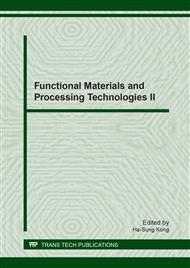[1]
T.V. Anikanova, Sh.M. Rakhimbayev, Foam Concretes for Intensive Technologies of Construction, Publishing Office of the Belgorod State Technical University, Belgorod, (2015).
Google Scholar
[2]
N.V. Pavlenko, P.P. Pastushkov, A.N. Kharkhardin, E.V. Voytovich, Research of Mutual Dependence of Structural and Heat and Moisture Properties by the Example of Foam Concrete based on Nano-Structured Binding. Bulletin of the Siberian State Automobile and Highway Academy. Vol. 6, No 52 (2016).
Google Scholar
[3]
Z. Zhang, J.L. Provis, A. Reid, H. Wang, Mechanical, Thermal Insulation, Thermal Resistance and Acoustic Absorption Properties of Geopolymer Foam Concrete. Cement and Concrete Composites. 62 (2015) 97-105.
DOI: 10.1016/j.cemconcomp.2015.03.013
Google Scholar
[4]
S.V. Aleksandrovsky, Applied Approaches of the Theory of Thermal Conductivity and Concrete Moisture Conductivity, Sputnik+, Moscow, (2001).
Google Scholar
[5]
V.S. Cherednichenko, V.A. Sinitsyn, A.I. Aliferov, Heat Transfer. Basics of Heat Transfer Theory, Publishing Office of Novosibirsk State Technical University, Novosibirsk, (2007).
Google Scholar
[6]
A.U. Franchuk, Tables of Construction Materials Heating Performance, the USSR State Committee for Construction, Scientific Research Institute of Experimental Physics, Moscow, (1969).
Google Scholar
[7]
V.M. Ilyinsky, Construction Thermal Physics (Enclosure Structures and Environment of the Buildings), High School, Moscow, (1974).
Google Scholar
[8]
Yu.P. Gorlov, Technology of Thermally-Insulating and Acoustic Materials and Products, High School, Moscow, (1989).
Google Scholar
[9]
V.A. Gurtov, R.N. Osaulenko, Solid State Physics for Engineers, Technosphere RIC, Moscow, (2012).
Google Scholar
[10]
K.F. Fokin, Construction Thermal Technology of Enclosing Building Elements, Moscow, AVOK-PRESS, (2006).
Google Scholar
[11]
I.N. Kuznetsova, Influence of Chemical and Mineral Concrete Composition and Heat-Insulating Properties of Foam Concrete, Extended Abstract of Dissertation in Candidacy for a Degree of the Candidate of Technical Sciences, Novosibirsk, (2009).
Google Scholar
[12]
T.K. Nagashibayev, Development of Technological Parameters for Manufacturing Efficient Thermal Insulation from Non-Autoclaved Aerated Concrete, Extended Abstract of Dissertation of Candidate of Technical Sciences, Moscow, (1997).
Google Scholar
[13]
R.I. Budeshtskiy, Elements of Strength Theory of Granular Composites (the type of concretes), Metsniereba, Tbilisi, (1972).
Google Scholar
[14]
A.G. Komar, E.G. Velichko, Zh.S. Belyakova, On Some Aspects of Managing Structural Formation and Properties of Portland Blast Furnace Foam Concrete, Construction Materials. 7(2001) 12-17.
Google Scholar
[15]
M.S. Polukhin, V.G. Peychev, The Method of Manufacturing Hydrophobic Shallow Microspheres based on Perlite. Patent of the Russian Federation No. 2531970, priority dated 05/ 21/(2013).
Google Scholar
[16]
V.G. Peychev, Method of Complex Perlite Processing. Patent of the Russian Federation No. 2531966, priority dated 05/30/(2013).
Google Scholar
[17]
T.S. Yusupov, R.G. Melkonyan, V.V. Nasedkin, L.M. Nagayeva, A.P. Korotchenko, A.N. Doronin, Method for Producing Amorphous Silica. Patent of the Russian Federation No. 2261840, priority dated 06/18/(2004).
Google Scholar
[18]
V.S. Lesovik, A.V. Mospan, V.V. Strokova, L.N. Solovyeva, R.V. Lesovik, Granular Filler for Concrete Mixture based on Perlite, Composition of Concrete Mixture for Producing Construction Products, Method for Producing Concrete Construction Products and a Concrete Construction Product. Patent of the Russian Federation No. 2358937, priority dated 11/15/(2007).
DOI: 10.1680/scc.31777.0017
Google Scholar


